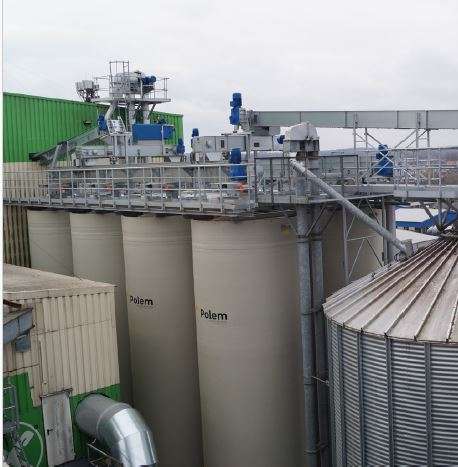In 2023, Raiffeisenagrar installed eight Polem composite silos at its feed production site in Ankum. “The difficult flowing raw materials such as turnip and soybean meal flow easily out of these silos. The silos stay clean and work fine,” said Thorsten Kühl, operations manager of the feed mill in Lower Saxony, Germany.
Kühl is also super satisfied with the cooperation with Polem. The feed mill has been using the silos since spring 2023. “After a year, we can say that we dare to store everything in these silos. Difficult flowing products such as
soybean and rape meal are unloaded effortlessly. The product flows like a column to the output. Even chocomeel, cocoa with a flour component, I dare to store in it,” says Thorsten Kühl. He has not had any jammed products in the composite silos in the past year. “There is a hammer ban here,” Thorsten Kühl says with a laugh. A hammer is also absolutely unnecessary. The silos are equipped with a vibrating floor to facilitate product unloading.
Steep outflow angle
Raiffeisenagrar installed eight composite silos of 160 m³ capacity each. Between the building and the steel silos, the eight composite silos do stand out. They are a total of 26 meters high and have a diameter of 3.48 meters. Special features are the funnel outlet angles of 30 degrees which corresponds to a slope of 75 degrees. This absolutely guarantees mass flow. “This is exceptionally steep. As standard, this angle is 60 degrees,” explains Richard van Lierop, Polem account manager. Thorsten Kühl wanted absolute guarantee of good flow. He is pleased with the decision for the 30-degree angle. “Our experience is 100 percent first in - first out without de-mixing of products. If the product drops down like a column, you don't get any segregation.” A system of chain conveyors fills the silos from the top.
In 2014, the operations manager came into contact with Polem. “Thorsten Kühl was urgently looking for a tank for storing molasses, also a product with very specific requirements. We were then able to quickly produce and deliver that tank,” says fellow account manager Sjouke Miedema who, as account manager, maintained contact with Raiffeisenagrar.
Building for the future
Thorsten Kühl: “We started planning in 2013 how we wanted to make the feed mill ready for the future. We no longer wanted steel silos. They are not nice and smooth and something always sticks to the walls. We liked Polem's first composite silo and I was impressed with the quality.” In consultation with the cooperative's management and board, he was given a free hand to start implementing the plans. Together with Sjouke Miedema and engineers from Polem, he worked out the plans. They visited similar projects. By 2018, everything was concrete. In total, the entire modernization involves an investment of 2.5 million euros which includes the eight silos with supply and disposal facilities, electricity, the spacious platform and installation. A big investment but Polem silos guarantee 30 years of intensive use. Sjouke Miedema: “In practice, we see that our silos last 40 years and more.”
Preperation
“If you put a lot of time into preparation beforehand, you get a good end result,” says Sjouke Miedema. In the run-up to the project, he had a lot of contact with Thorsten Kühl and his team. Knowledge from both sides, the operational of the feed mill and the specific knowledge from Polem, is essential in the preparatory phase. “Nothing is more annoying than saying afterwards, if only we had done it differently,” the account manager knows. The feed manufacturer had consultations with Polem's account manager, project manager and engineers who also came to see the situation on site. “Consultation about width, height, bearing capacity, load on the silo, technical connections, integration of the silos in the factory, anchoring points; all these points require quite a bit of preparation. Once the silo is made in the hall in Lemmer, change is radical. Polem provided 3D drawings of the silos in advance for integration into the factory. “We do that to check 100 percent that the dimensions are correct and, for example, you don't get a conflict with the steel structures or the transport systems,” Sjouke Miedema explains.
Installation
Due to good preparation, the eight silos were installed in 1.5 days. “We had a crane here at the construction site that we could use for this. If not that you have to rent a mobile crane for installation,” said Thorsten Kühl.
He is very pleased with the cooperation with Polem. “They are always there for us, either Sjouke or one of his colleagues. The aftercare is also perfect; it's not deliver and go. That works very nicely.” The silos stay very clean inside. “Some products have a self-cleaning ability. Occasionally we put a load of unground corn or grain through them. That cleans the inside,” says Thorsten Kühl. The outside of the silos are still very clean after a year. A wash every few years is sufficient.
Cooperation with Polem before and after installation is perfect
Savings through weatherproof storage
Raiffeisenagrar location Ankum has deliberately invested in the new storage capacity. The silos are equipped with the necessary connections, including for possible disinfection and supply of inert gas. In addition, all eight silos are equipped with large manholes at the top and bottom. In the future, more poorly run products may be incorporated into the cattle feed. “These Polem composite silos can handle all products. Another advantage of the composite silos is the lack of condensation. There is little to none. Therefore, there is also no need to put a building around it. That saves a lot of costs. Therefore, think carefully about investments that new silos entail. You are doing that again for a generation. Silos at a feed mill are used intensively. The flow rate is high. That requires the best quality silos, for us Polem silos. Good throughput, maximum hygiene, expert project management and not least a competitive price-performance ratio,” Thorsten Kühl concludes.






